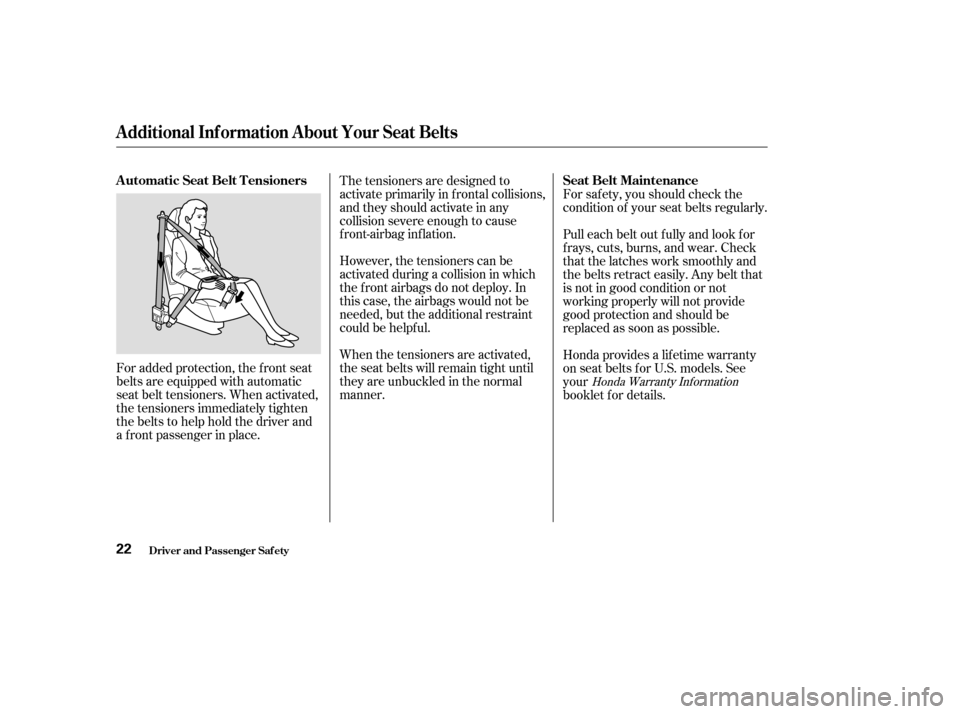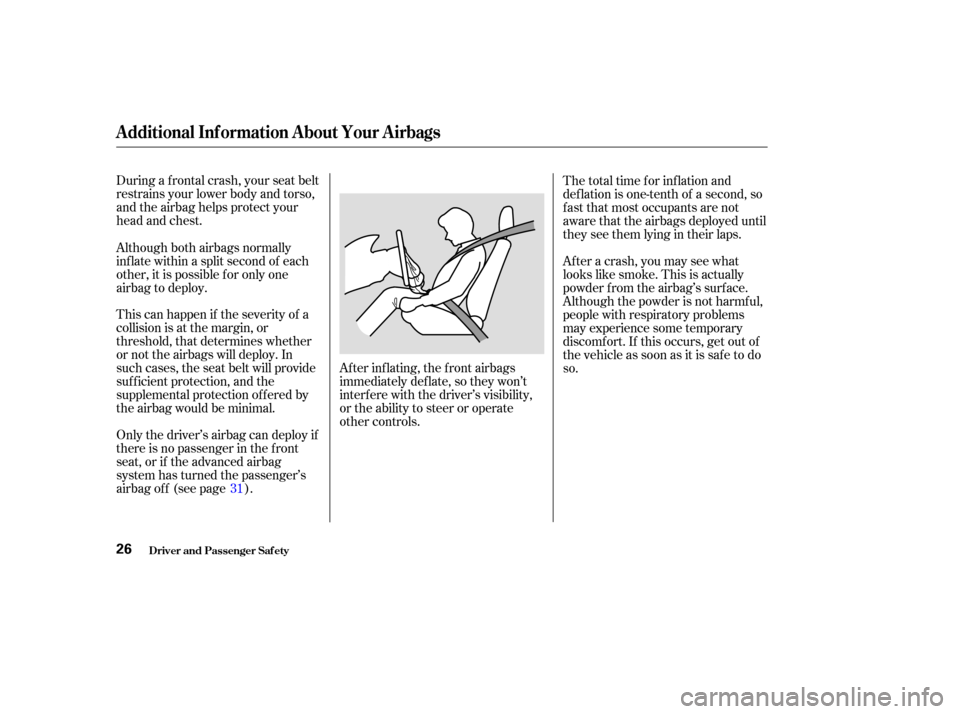Page 22 of 296

Devices intended to improve
occupant comf ort or reposition the
shoulder part of a seat belt can
reduce the protective capability of
the seat belt and increase the
chance of serious injury in a crash.
Carrying hard or sharp
objects on your lap, or driving with
a pipe or other sharp objects in
your mouth, can result in injuries
if your f ront airbag inf lates.
If your
hands or arms are close to an
airbag cover, they could be injured
if the airbag inf lates. Objects on
the covers marked ‘‘SRS AIRBAG’’
could interf ere with the proper
operation of the airbags. Or, if the
airbags inflate, the objects could
be propelled inside the vehicle and
hurt someone.
If a side airbag
inflates,acupholderorotherhard
object attached on or near the
door could be propelled inside the
vehicle and hurt someone.
This could make the driver’s
seat position sensor or the f ront
passenger’s seat weight sensors
inef f ective (see page f or
more inf ormation). This could
cause problems with the driver’s
seat position sensor or the f ront
passenger’s seat weight sensors
(see page f or more
inf ormation). 28
34
Protecting A dults and Teens
Driver and Passenger Saf ety
Do not put any accessories on seat belts.
Do not place hard or sharp object sbet ween yourself and a f rontairbag.
K eep your hands and arms awayf rom t he airbag covers. Do not at t ach or place object s on
the f ront airbag covers.
Do not at t ach hard object s on ornear a f ront door.
Do not modif y t he f ront seat s. Do not place any it ems under
t he f ront seat s.
19
Page 23 of 296

Your seat belt system includes lap/
shoulder belts in all seven seating
positions. The f ront seat belts are
also equipped with automatic seat
belt tensioners.Most seat belts are a one-piece lap/
shoulder belt. This seat belt goes
over your shoulder, across your
chest and across your hips.
To fasten the belt, insert the latch
plate into the buckle, then tug on the
belt to make sure the buckle is
latched (see page f or how to
properly position the belt).
To unlock the belt, push the red
PRESSbuttononthebuckle.Guide
the belt across your body so that it
retracts completely. Af ter exiting the
vehicle, be sure the belt is out of the
way and will not get closed in the
door.The seat belts in all positions except
the driver’s and the center seat in
the third row have an additional
locking mechanism that must be
activated to secure a child seat (see
page ).
If the shoulder part of the belt is
pulled all the way out, the locking
mechanism will activate. The belt
will retract, but it will not allow the
passenger to move f reely.
To deactivate the locking
mechanism, unlatch the buckle, and
let the seat belt f ully retract. To
ref asten the belt, pull it out only as
f ar as needed.
The seat belt system
includes an indicator on the
instrument panel to remind you and
your passengers to f asten your seat
belts.
If the driver’s seat belt is not
fastened before the ignition is turned
to ON (II), the indicator will come on
and a beeper will also sound. The
beeper will stop af ter a f ew seconds,
but the indicator will stay on until the
driver’s seat belt is f astened. 46
14
Additional Inf ormation About Your Seat Belts
Driver and Passenger Saf ety
Seat Belt System Components L ap/Shoulder Belt
(Except cent er posit ion of t hird row)
20
Page 24 of 296
�µAll seat belts have an emergency
locking retractor. In normal driving,
the retractor lets you move f reely in
your seat while it keeps some
tension on the belt. During a collision
or sudden stop, the retractor
automatically locks the belt to help
restrain your body.
To unlatch the belt, push the red
PRESS button on the buckle and
detach the shoulder belt f rom the lap
belt.
When properly assembled, the
combination lap belt and shoulder
belt in this position goes over your
shoulder, across your chest, and
over your hips (see pages for belt assembly, latching, and
positioning instructions). 15
16
Additional Inf ormation About Your Seat Belts
Driver and Passenger Saf ety
(Cent er posit ion of t hird row)
21
Page 25 of 296

For added protection, the f ront seat
belts are equipped with automatic
seat belt tensioners. When activated,
the tensioners immediately tighten
the belts to help hold the driver and
a f ront passenger in place.The tensioners are designed to
activate primarily in f rontal collisions,
andtheyshouldactivateinany
collision severe enough to cause
front-airbag inflation.
However, the tensioners can be
activated during a collision in which
the f ront airbags do not deploy. In
this case, the airbags would not be
needed, but the additional restraint
could be helpf ul.
When the tensioners are activated,
the seat belts will remain tight until
they are unbuckled in the normal
manner.
For saf ety, you should check the
condition of your seat belts regularly.
Pull each belt out f ully and look f or
f rays, cuts, burns, and wear. Check
that the latches work smoothly and
the belts retract easily. Any belt that
is not in good condition or not
working properly will not provide
good protection and should be
replaced as soon as possible.
Honda provides a lif etime warranty
on seat belts f or U.S. models. See
your
booklet f or details.
Honda Warranty Inf ormation
Additional Inf ormation About Your Seat Belts
Driver and Passenger Saf ety
A utomatic Seat Belt T ensioners
Seat Belt Maintenance
22
Page 26 of 296
If a seat belt is worn during a crash,
it must be replaced by the dealer. A
belt that has been worn during a
crash may not provide the same level
of protection in a subsequent crash.
The dealer should also inspect the
anchors f or damage and replace
them if needed. If the automatic seat
belt tensioners activate during a
crash, they must be replaced.
For inf ormation on how to clean your
seat belts, see page .226
Additional Inf ormation About Your Seat Belts
Driver and Passenger Saf ety23
Not checking or maintaining
seat belts can result in serious
injury or death if the seat belts
do not work properly when
needed.
Check your seat belts regularly
and have any problem
corrected as soon as possible.
Page 27 of 296

Two side airbags, one f or the
driver and one f or a f ront
passenger. The airbags are stored
in the outer edges of the seat-
backs. Both are marked ‘‘SIDE
AIRBAG’’ (see page ).
Automatic seat belt tensioners
(see page ).
Sensors that can detect a
moderate to severe frontal or side
impact.
Your Airbag System includes:
Two SRS (Supplemental Restraint
System) f ront airbags. The driver’s
airbag is stored in the center of
the steering wheel; the f ront
passenger’sairbagisstoredinthe
dashboard. Both are marked ‘‘SRS
AIRBAG’’ (see page ).
22 29
25
Additional Inf ormation About Your Airbags
Driver and Passenger Saf ety
A irbag System Components
24
(8)
(3)
(4)
(6)
(10)
(5) (11) (1) (8) (9)
(2)
(10)
(4)
(7)
(5)
(7)
(1) Driver’s Front Airbag
(2) Passenger’s Front Airbag
(3) Control Unit
(4) Seat Belt Tensioners
(5) Side Airbags
(6) Driver’s Seat Position Sensor (7) Front Passenger’s Weight Sensors
(8) Front Impact Sensors
(9) Passenger Airbag Off Indicator
(10) Side Impact Sensors
(11) Occupant Position Detection
System (OPDS) Sensors
Page 28 of 296

CONT INUED
A sophisticated electronic system
that continually monitors and
records inf ormation about the
sensors, the control unit, the
airbag activators, and driver and
frontpassengerseatbeltusewhen
the ignition is in the ON (II)
position.
Weight sensors that monitor the
weight on the f ront passenger’s
seat. These prevent the passenger’s
f ront airbag f rom inf lating if the
weight is less than about 65 lbs
(30 kg) (see page ).
An indicator on the instrument
panel that alerts you to a possible
problem with your airbags (see
page ).An indicator on the instrument
panel that alerts you that the f ront
passenger’s side airbag has been
turned of f (see page ).
An indicator on the dashboard that
alerts you that the passenger’s
f ront airbag has been turned of f
(see page ).
Emergency backup power in case
your vehicle’s electrical system is
disconnected in a crash.
A driver’s seat position sensor that
monitors the seat position. If the
seat is too far forward, the airbag
will inf late with less f orce (see
page ).
If you ever have a moderate to
severe f rontal collision, sensors will
detect the vehicle’s rapid
deceleration. If the rate of
deceleration is high enough, the
control unit will instantly inf late the
driver’s and f ront passenger’s f ront
airbags, at the appropriate time and
with the f orce needed.
28
30 31
32
28
Additional Inf ormation About Your Airbags
Driver and Passenger Saf ety
How Your Front Airbags Work
25
Page 29 of 296

During a f rontal crash, your seat belt
restrains your lower body and torso,
and the airbag helps protect your
head and chest.
This can happen if the severity of a
collision is at the margin, or
threshold, that determines whether
or not the airbags will deploy. In
such cases, the seat belt will provide
suf f icient protection, and the
supplemental protection of f ered by
the airbag would be minimal.Af ter inf lating, the f ront airbags
immediately def late, so they won’t
interf ere with the driver’s visibility,
or the ability to steer or operate
other controls.The total time for inflation and
def lation is one-tenth of a second, so
f ast that most occupants are not
aware that the airbags deployed until
they see them lying in their laps.
After a crash, you may see what
looks like smoke. This is actually
powder f rom the airbag’s surf ace.
Although the powder is not harmf ul,
people with respiratory problems
mayexperiencesometemporary
discomf ort. If this occurs, get out of
the vehicle as soon as it is saf e to do
so.
Only the driver’s airbag can deploy if
there is no passenger in the f ront
seat, or if the advanced airbag
system has turned the passenger’s
airbag off (see page ). Although both airbags normally
inf late within a split second of each
other, it is possible f or only one
airbag to deploy.
31
Additional Inf ormation About Your Airbags
Driver and Passenger Saf ety26